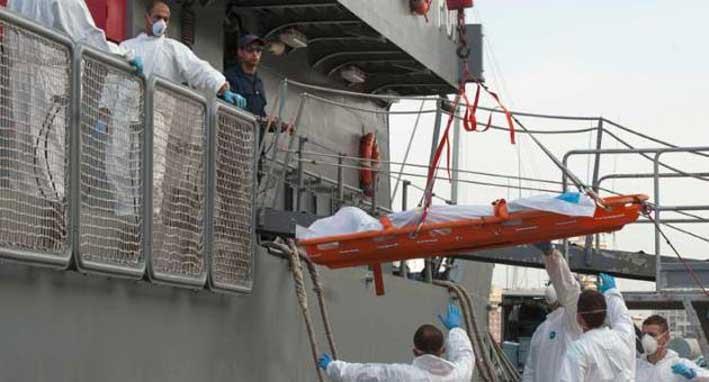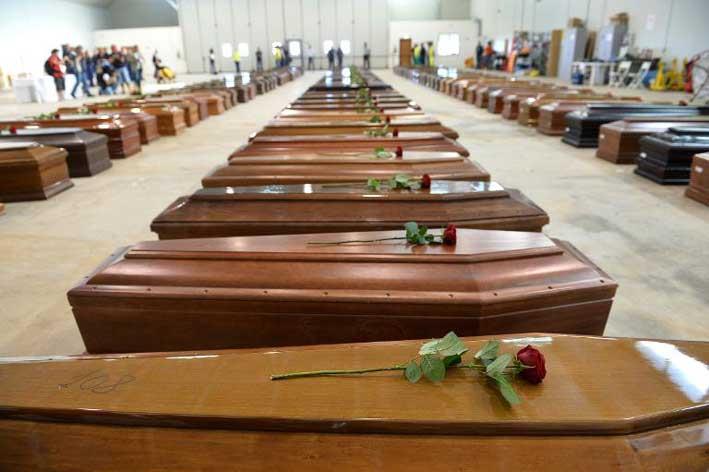A number of Italian navy officers have been placed under investigation and are expected to stand accused before the Italian courts of manslaughter and failure to render assistance during the 11 October 2013 migrant tragedy.
Malta was also involved in the botched rescue attempt, which claimed the lives of 268 Syrians, many of whom were children, fleeing hostilities in the country. Another 212 Syrians had been rescued by the Italian and Maltese navies in what was one of the worst cases witnessed in the Mediterranean, and certainly the worst in which Malta was involved.
Several Italian navy officers are under investigation for manslaughter by Rome public prosecutors Francesco Scavo and Santina Lionetti, who are seeking to determine how exactly Italian forces responded, or failed to respond, on the fateful day and to attribute responsibility for the mass loss of life.
On the day in question, the boat full of Syrian refugees sank 113 kilometres from the Italian island of Lampedusa and 218 kilometres from Malta, in Maltese territorial waters.
The vessel went down after an excessive number of passengers rushed to one side of their vessel as they were being forced to board a dilapidated fishing vessel by unscrupulous smugglers from the Libyan port of Zuwara. The ship had also been hit by machine gun fire from a Libyan patrol boat the night before, puncturing its hull.

Malta’s involvement
Malta was also involved in the rescue attempt and although the Maltese media, including this newsroom, had bombarded the Armed Forces of Malta for information, as well as Freedom of Information requests, such requests were consistently denied.
However, documents, maps and eye-witness accounts seem to indicate that the Maltese government took what was the riskiest and least logical of the six choices it had available on 11 October 2013, when the country was tasked with coordinating the rescue of hundreds of Syrian migrants off Lampedusa.
Any of the other five choices arguably could have prevented the migrant tragedy, but all the available evidence leads to the conclusion that Malta had tried to rescue the migrants on its own, instead of asking for the assistance that was available.
This ill-fated decision seems to have backfired, and close to 270 Syrian men, women and children could very well have paid the ultimate price for that mistake.
Eye-witness accounts, official press releases and investigations by Italian journalist Fabrizio Gatti in the weeks after the tragedy show that a number of vessels – Italian military, coast guard, fishing and merchant – could have reached the migrant boat hours before it capsized and sank with hundreds of passengers on board. But the Maltese authorities chose not to involve these assets and relied instead on sending an AFM patrol boat from 230 kilometres away.
Since the ship carrying the Syrian refugees had been in difficulties in Malta’s assigned search and rescue area, it was Malta that was in command of the whole operation, and it was Malta that was responsible for giving the go-ahead for the mobilisation of Italian or commercial maritime assets in the area – a go-ahead that had been given too late in the day and not until the ship had actually sunk for the 270 victims of the tragedy.
The tragedy came at a time when the Maltese government had been under fire for trying to adopt a policy of forcibly returning irregular migrants to Libya, and only a few days after another tragedy – on 3 October – had left more than 360 migrants dead in the waters near Lampedusa.
Further fuelling speculation about the way events unfolded on that fateful day, the Maltese government and the Armed Forces of Malta have always refused to answer any questions about the incident from the Maltese and foreign media.

Malta had six options, but made the wrong choice
According to Syrian medic Mohammad Jammo, who was the person who called for help that day, the fishing boat the refugees were on was crammed with around 400 passengers on board and it was sinking, having sustained machine-gun fire from a Libyan vessel the night before.
Dr Jammo, who lost two sons in the tragedy, claimed that he first called the Italian authorities via satellite phone at 11am. He claimed that the Italian authorities had assured him that help was coming, only to be told two hours later to call the Maltese authorities.
In reply to the news report, Admiral Felicio Angrisano, General Commander of the Rome Maritime Rescue Coordination Centre, said that Dr Jammo’s version was incorrect. “The first call for help was received at 12.26pm and not at 11pm as stated by the Syrian doctor.”
Admiral Angrisano also said that RCC Malta had been informed about the incident by 1 pm and five minutes later the Maltese authorities had taken over command of the situation.
But even so, the tragedy could have still been avoided, as Malta had at least six options.

Option One: merchant ships
The Italian Admiral said that Malta’s Rescue Coordination Centre had been informed of the situation at 1pm. In a right-of-reply statement to L’Espresso, he said that Malta was advised about the vessels that were closest to the migrant boat.
Among these were two merchant ships – the Stadt Bremenhaven and the Tyrusland. These ships were 25 and 70 miles away, respectively. It is known that the marine Safety Net communication system alerted all ships in the area about the migrant boat and asked mariners to “keep a lookout and assist if possible”.
However, the transmission is not addressed to any particular vessel and it is not known if the Maltese authorities asked the merchant vessels to help the migrants. What is known is that both ships kept steaming ahead.
However, the Maltese government has never claimed – as it has done in previous cases – that the ships had ignored calls for help.

Option Two: the ITS Libra
Admiral Angrisano clearly stated that RCC Malta was also advised that the Italian warship ITS Libra was 50 kilometres away. However, the ship was not instructed to proceed to the migrant boat and continued patrolling the area at a slow speed for the next four hours.
Malta finally requested the help of the Italian navy at 5.10pm, after the migrant boat had rolled over and sunk. The ITS Libra arrived at the scene at 6pm.
Option Three: Italian coastguard vessels
It is also known that a number of Italian coastguard vessels were operating in the area. The CP401, CP290 and CP312 were in the vicinity of Lampedusa, around 100 kilometres away from the migrant boat. But they were not dispatched.
CP301 and CP302 – which were anchored in Lampedusa – only left port at 5.49pm – half-an-hour after the boat had capsized. And they arrived on site at 8.20pm – the trip having taken just two hours, 30 minutes.
If the Guardia Costiera vessels had left port at 1pm, they would have arrived on site at 3.30pm – a full hour-and-a-half before the tragedy.

Option Four: Guardia di Finanza patrol boats
There were also two Zara class patrol boats from the Guardia di Finanza in Lampedusa. With their speed of 40 knots, they could have reached the boat in an hour-and-a-half, but at 5.26pm they were still moored in port. These boats were also not instructed to assist.
Admiral Angrisano made it clear that the Italian vessels could not act without a request from the coordinating country – Malta. “The RCC in charge decides the time and method of rescue.”
Option Five: fishing trawlers
AIS data provided by migrant organisation Watch the Med also show that two Italian fishing trawlers – the Chiaraluna and the Famavia – were very close to the migrant boat. At 6.15pm, both were sailing towards the disaster area but this was a full 20 minutes before a new, more urgent Safety Net message was broadcast. This could very well indicate that the fishing vessels were acting at the request of the Maltese authorities. Whatever the case, such a request could have been made much earlier.

Option Six: going it alone
The sixth and final option was to keep all Italian military and civilian assets on standby and to send in a Maltese patrol boat – the P61. And for some strange reason, this was the option chosen by the Maltese government.
The P61 was the boat furthest away from the migrant boat. And, with a top speed of 23 knots, it was also slower than the Italian boats and had a much greater distance to travel.
At the time of the capsizing, the migrant boat was 230 kilometres from Malta and some 100 kilometres from Lampedusa. The P61 eventually arrived on site at 5.51pm – by which time the migrants had been in the water for more than 40 minutes and most of the children had long since died.
Malta also flew in a King Air maritime patrol aircraft. The take-off time is not known but the plane spotted the migrant boat at 4pm – by which time Malta had the boat’s exact coordinates.
The plane’s crew witnessed the sinking of the migrant boat and threw life rafts and life jackets into the sea. It reported the boat’s capsize to the Malta RCC and it was only at this time, at the 11th hour and when it was already too late for many of the victims, that the decision to mobilise the Italian assets was finally taken.
Vessels near accident site finally sent to help
In his version of events, the Italian Admiral said that after the migrant boat finally sank, the Maltese authorities asked Italy for help and at this time the fleet available for rescue included one Maltese patrol boat, the ITS Libra, boats from the Guardia di Finanza and from the Guardia Costiera, two Italian fishing boats that were already in the area and a merchant ship that was re-routed by Malta.
This further confirms that there were various options available, with a number of vessels that could have at least helped the migrants until the Maltese patrol boat arrived.
When asked why the Italians had not responded to the crisis earlier, the Italian Admiral replied that the Maltese were in charge and the Italians could not intervene before receiving orders to do so. It is also understood that as soon as the Italians received the call to scramble, following the capsize of the migrant boat, they responded immediately. The Italians, it seems, were not reluctant to help.
Additional reporting by Neil Camilleri